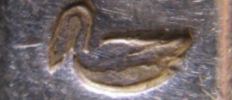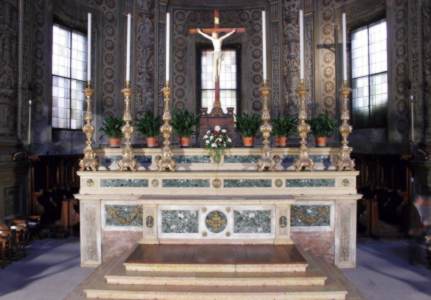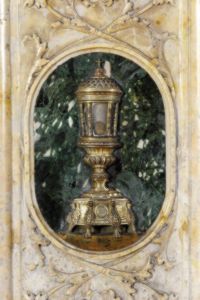by Franco
Negrini and Francesca Rapposelli
(click on photos to enlarge image)
SILVERSMITHING IN MANTUA FROM THE 14TH TO THE 19TH CENTURY
- part 1 - (note 1.a)
The recent discovery of a silver spoon with the rare
mark of the "swimming swan" offers the opportunity to
retrace the evolution of the silver hallmarking system
in Mantua from the 14th to the 19th century.
August 19, 1310 is the date commonly considered as the
beginning in Mantua of regulations issued to protect
buyers from fraud and to certify the quality of the
silver alloy. On this date "capitano" Rinaldo Bonacolsi (people's captain)
(note 1.b) officially approved the
"Statuti dell'Arte degli Orefici" (Silversmiths'
statutes).
Thereafter, from the 16th to the 19th century numerous
other decrees were published to confirm as mandatory the
fineness of the alloy used by Mantua's mint, or to prescribe
the regulations to be followed in the manufacture of
precious metals
The first warranty mark used in Mantua was "Virgil's
head", (note 1.c)
the emblem of the "Comune" (Town symbol), of its
independent government (Free Commune), and of the town
mint that, in addition to coinage, was also responsible for
verifying that weights, measures of capacity and lengths
conformed to the models kept in the Town hall.
|
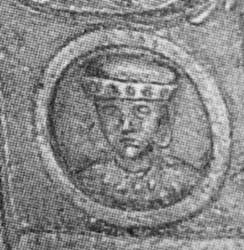 |
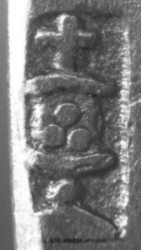 |
In 1616, following the request of Mantua's
silversmiths, Duke Ferdinando Gonzaga authorized the
replacement of the Virgil's head with the "Sacred Vessels"
image on the warranty silver mark. The new mark
represented the Reliquary containing the "Precious Blood
of Christ", an object of deep religious reverence in Mantua since 1611.
This reliquary was alternatively known as
"calyx", "vessel" or "pyx".
The mark was a rectangle incused with the reliquary,
containing three portions of earth dipped with the blood
of Our Lord, standing on a bell shaped base and covered by a
lid with a cross on the top.
(note 2)
|
Plain evidence of the shape of the ancient Sacred Vessels is
present in Gonzaga's coins and in many decorations of Saint
Andrew's Basilica in Mantua, where the Sacred Relic is held.
St. Andrew's was for a long time the largest construction site of
the town. Its long and troubled history is inextricably linked
to the conservation and to the cult of the "Precious Blood of
Christ".
Built in medieval times, it was rebuilt, starting in 1472, on a
design of Leon Battista Alberti, but works proceeded slowly.
Well documented are the decorative interventions at the end of
the 18th century by the architect Paolo Pozzo (Verona 1741 -
Mantua 1803) and the goldsmith and decorator Giovanni Bellavite
(Verona 1739 - Mantua 1821).
To their collaboration we owe the Main Altar, where the Sacred
Vessels are represented on side pilasters.
Of particular historical importance is the decree dated
April 6, 1621 confirming the mandatory use of two marks to
warrant the fineness degree of silver alloys. For any object
manufactured in precious metal the presence of two marks was
required: a silversmith's mark, to identify the workshop and
an assay mark, placed by the town mint to certify the quality of
the silver alloy.
In the second half of the 17th century a new duty was requested
by the town mint for assaying metals. The representations of
precious metal manufacturers and the following ambitious
initiative of silversmith Gasparo Taliani lead to a modification
of the hallmarking system.
Gasparo Taliani, born in Pontremoli,Tuscany, arrived in Mantua
in the 1640s. The city and its territory were still affected by
serious consequences of Landsknecht's besiege and sacking in 1630. The
ensuing plague decimated most of the population.
(note 1.d)
The reduction of the city to six thousand inhabitants and to a
little over twenty-four thousand in the countryside bears witness
of the extreme brutality of that time. The Duke Charles I
Gonzaga-Nevers (1628-1637) demonstrated great intelligence and
organizational capacity to promote demographic recovery and to
support trade and agricultural activities. The reconstruction
work was continued by his successors, especially the Duchess Maria
Gonzaga (1637-1647), regent for his son Charles II Gonzaga-Nevers
(1647-1665), and then by Charles II itself in the early years of
his Government. This brought some hope of new prosperity but was
unable to stop the decline which began with the reckless policy of
Duke Vincenzo Gonzaga II (1626-1627) and continued to the end of the direct
line of the Gonzaga family.
To reactivate agriculture and industry and to increase the number
of residents, new facilities and privileges were introduced for
anyone who would come to live and work in the Duchy. It was certainly these
privileges and the favourable economic conditions that attracted
and convinced the silversmith Taliani to transfer his family and
his activities in Mantua. Gasparo had an enterprising character,
sometimes cheeky, and did not fear to play his chances. He had a
strong desire to become a citizen of Mantua, notwithstanding the
rigid rules necessary to obtain such social promotion, which
required rigid economic conditions, high workmanship and
recognized moral behaviour. It was necessary to be a permanent
resident for several years, to possess real estate properties
in the Duchy, and to be engaged in a lawful profession for the decent maintenance of the family.
Taliani made a great effort in his attempt to obtain Mantua citizenship and the production of his
workshop, where his son Francesco was active also, maintained
a high level of workmanship and offered profitable income for his
family.
Taliani, like all other silversmiths-goldsmiths of the Duchy
of Mantua, had the punch required by hallmarking rules to
identify his workshop: the mark was a "crescent moon" with the
letters "SIC" in the center (
(note 3). By appointment of the Duke, in 1661 Gasparo
Taliani was entrusted with an important and prestigious task: to
assay and to warrant silver fineness of the artifacts manufactured
by Mantua's silversmiths.
After his nomination to assayer Taliani, to verify the assay,
imposed the use of his "SIC" mark instead of the ancient and
traditional "Sacred Vessels" mark. This behaviour was considered
not fair by his fellow silversmiths as any piece bearing the
"SIC" mark could be incorrectly interpreted by customers as
manufactured by Taliani's workshop.
The quarrel was solved by requiring Taliani to use the
ancient mark (Sacred Vessel) coupled with his personal "SIC"
mark.
The use of this pair of marks was maintained and respected for
a long time, assuming the function respectively of "town mark" (Sacred
vessel) and official fineness warranty (SIC).
After 1661 Taliani changed his workshop mark to a "cup" and,
later, this symbol was used also by his son Francesco and his
grandson Gasparo Cristofaro.

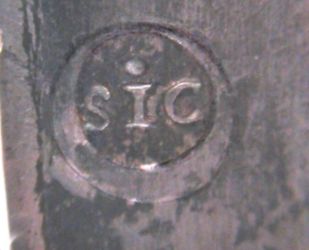
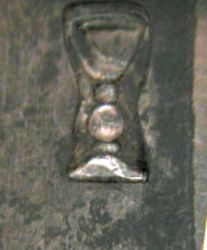
|
left: 'Sacred Vessel' mark used as town mark
center: 'SIC' mark used as official fineness
warranty (previously Taliani workshop mark)
right: 'cup' mark used as Taliani workshop mark (coupled
to "SIC", used as official fineness warranty mark)
|
Unfortunately, few examples of Taliani's production
still survive (note
4): melting ancient objects damaged or out of
fashion was a common practice.
Furthermore, in the last decade of the 18th century
three requisitions of silver were imposed by the
Austrian Government (1796) and by Napoleon (1797 and
1799) to support the needs of their warring armies
(note 1.e).
These requisitions deprived Mantua of highly valuable
artifacts belonging to their historical and artistic
heritage. Descriptions of these masterpieces remain only in
archival documents.
|
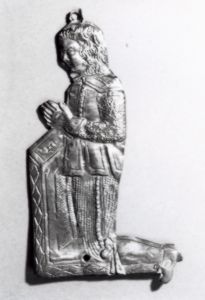
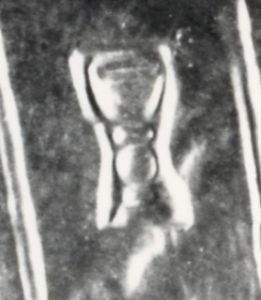 |
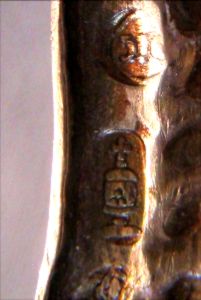
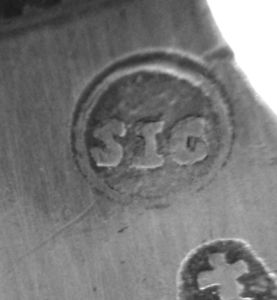 |
The addition of the third mark completed the transition
to the new hallmarking system.
These symbols, albeit with slight variations, would remain in
use until the Napoleonic reforms.
|
A pair of candlesticks attributed to the workshop of
Mantua's silversmith Domenico Strada bearing the "three
marks".
Similar works were commonly a serial production for
general use. They are realized in "barocchetto", a style
highly appreciated and widespread in the second half of
the 18th century also in France and Germany.
|
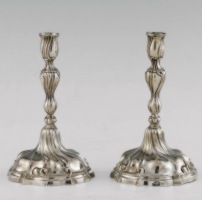
 |
The study and understanding of these small marks is
of fundamental importance for makers' identification
(alongside another example).
|
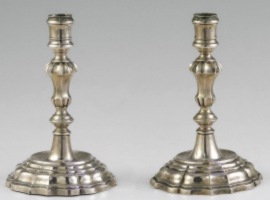
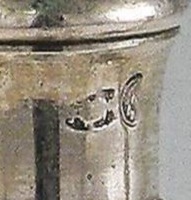 |
ENDNOTES
(note 1.a) Mantua (in Italian:
Māntova) is a city in Lombardy, Italy and capital of the
province of the same name.
The city was founded, probably around 2000 BC, on the banks of
the Mincio, on a sort of island which provided natural
protection. In the 6th century BC it was an Etruscan village
which, in Etruscan tradition, was re-founded by Ocno.
The name derives from the Etruscan god Mantus, of Hades. After
being conquered by the Cenomani, a Gallic tribe, the city was
conquered by the Romans between the first and second Punic wars,
confusing its name with Manto, a daughter of Tyresia (Tiresias).
The new territory was populated by veteran soldiers of Augustus.
Mantua's most famous ancient citizen is the poet Publius
Virgilius Maro, Virgil (note 1.c),
who was born near the city in 70 BC.
After the fall of the Roman Empire, Mantua was invaded in turn
by Byzantines, Longobards and Franks. In the 11th century it
became a possession of Boniface of Canossa, marquis of Toscana.
The last ruler of the family was the countess Matilda of Canossa
(d. 1115).
After the death of Matilde of Canossa, Mantua became a free
commune, and strenuously defended itself from the Holy Roman
Empire in the 12th and 13th centuries.
Between 1215 and 1216 the city was under the podesteria of the
Guelph Rambertino Buvalelli. During the struggle between the
Guelphs and the Ghibellines, Pinamonte Bonacolsi took advantage
of the chaotic situation to seize power in 1273. His family
ruled Mantua for the next century, making it more prosperous and
artistically beautiful. On August 16, 1328, the last Bonacolsi,
Rinaldo (note 1.b), was overthrown
in a revolt backed by the House of Gonzaga, a family of
officials.
Luigi Gonzaga, who had been podestā of the city in 1318, was
elected "People's Captain". The Gonzaga built new walls with
five gates and renovated the architecture of the city in the
14th century, but the political situation in the city did not
settle until the third Gonzaga, Ludovico I of Gonzaga,
eliminated his relatives, seizing power for himself.
Through a payment of 120,000 golden florins in 1433,
Gianfrancesco I was appointed marquis of Mantua by Emperor
Sigismund, whose daughter Barbara of Brandenburg he married.
Under Francesco II the famous Renaissance painter Andrea
Mantegna worked in Mantua as court painter, producing some of
his most outstanding works.
The first duke of Mantova was Federico II of Gonzaga, who
acquired the title from Emperor Charles V in 1530.
In 1627, the direct line of the Gonzaga family came to an end
with the vicious and weak Vincenzo II, and the town slowly
declined under the new rulers, the Gonzaga-Nevers, a cadet
French branch of the family. The War of the Mantuan Succession
broke out, and in 1630 an Imperial army of 36,000 Landsknecht
mercenaries besieged Mantua, bringing the plague with them
(note 1.d). Mantua never recovered
from this disaster. Ferdinand Carlo IV, an inept ruler whose
only aim was to hold parties and theatrical representations,
allied with France in the Spanish Succession War. After the
latter's defeat, he took refuge in Venice, carrying with him a
thousand pictures. At his death, in 1708, he was declared
deposed and his family lost Mantua forever in favour of the
Habsburgs of Austria.
Under Austrian rule, Mantua enjoyed a revival, and during this
period the Royal Academy of Sciences, Letters and Arts, the
Scientific Theatre, and numerous Palaces were built.
On June 4, 1796, during the Napoleonic Wars, Mantua was besieged
by Napoleon as a move against Austria, who joined the First
Coalition. Austrian and Russian attempts to break the siege
failed, but spread the French thin enough to abandon the siege
on 31 July to fight other battles. The siege resumed on August
24. In early February the city surrendered and the region came
under French administration (note 1.e).
After the brief French rule, Mantua returned to Austria in 1814,
becoming one of the Quadrilatero fortress cities in northern
Italy. Agitation against Austria culminated in a revolt which
lasted from 1851 to 1855, and was finally suppressed by the
Austrian army.
In 1866, Mantua was incorporated in united Italy by the king of
Sardinia.
(an abstract from Wikipedia: The Free Encyclopedia)
(note 2) At the beginning of the 18th
century the mark's outline was modified to oval, while the "crescent"
on "SIC" mark was modified to a circle.
F. Rapposelli, Repertorio degli orefici mantovani. Maestri,
botteghe e punzoni dal XVII al XIX secolo, in dOro e dArgento,
Castel Goffredo 2006, p. 166
(note 3) A pennant with "crescent"
and "SIC" was adopted in 1595 in by Duke Vincenzo I Gonzaga on the
occasion of his military expedition against Turks in Hungary.
The original sense of this symbol is unknown. Attempts to solve
the mystery were made by I. Typotius on his long and
philosophical work Symbola divino et humana pontificum
imperatorum regum. Accessit brevi set facilis Isagoge, III,
Frankfurt 1642 and by G. Asiani, Istoria del Sangue
tratto dal costato di Gesų Cristo per Longino mentre pendeva in
croce e per lui portato a Mantova, Mantua 1609.
Further interpretations were offered by M. G. Grassi, I
medaglioni reliquiario di Vincenzo I Gonzaga, in "Civiltā
Mantovana" n. 21, 1988, nota n. 20, pp. 18-21; R. Signorini,
Stemmi, imprese e motti gonzagheschi, in Monete e Medaglie di
Mantova e dei Gonzaga dal XII al XIX secolo. La collezione della
Banca Agricola Mantovana, Milan 1996, pp. 128-129.
(note 4) Further information about
Taliani's activity can be found at: F. Negrini-F. Rapposelli, Dal "SIC"
del Taliani al "Cigno natante", in "Civiltā Mantovana" n. 124,
2007, pp. 148-165
Franco Negrini and Francesca Rapposelli
- 2008 -
English version of this article translated by Giorgio
Busetto
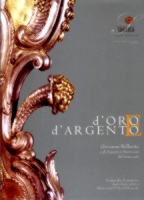 |
Francesca Rapposelli is the Curator of the book
"d'Oro e d'Argento - Giovanni Bellavite e gli Argentieri
Mantovani del Settecento" of which Franco Negrini is a
co-author.
The book was published for the Exhibition sponsored by
"Gruppo San Luca Onlus, Castel Goffredo, (Mantua, Italy),
from March 19 to June 18, 2006. In this book is also
presented an interesting directory of Mantua's
Silversmiths from the 17th to the 19th century
For information about this book, contact Corrado Bocchi: bocchi@email.it
|
|
|
 ASSOCIATION OF SMALL COLLECTORS OF ANTIQUE SILVER
ASSOCIATION OF SMALL COLLECTORS OF ANTIQUE SILVER







